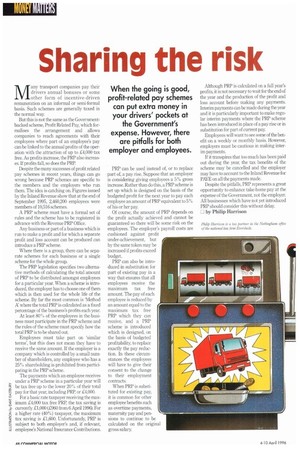Sharing the risk
Page 50

If you've noticed an error in this article please click here to report it so we can fix it.
When the going is good, profit-related pay schemes can put extra money in your drivers' pockets at the Government's expense. However, there are pitfalls for both employer and employees.
Many transport companies pay their drivers annual bonuses or some other form of incentive-driven remuneration on an informal or semi-formal basis. Such schemes are generally taxed in the normal way.
But this is not the same as the Governmentbacked scheme, Profit Related Pay, which formalises the arrangement and allows companies to reach agreements with their employees where part of an employee's pay can be linked to the annual profits of the operation with the attraction of up to £4,000 tax free. As profits increase, the PRP also increases. If profits fall, so does the PRP.
Despite the many successes of profit related pay schemes in recent years, things can go wrong because PRP schemes are specific to the members and the employers who run them. The idea is catching on. Figures issued by the Inland Revenue show that at the end of September 1995, 2,460,200 employees were members of 10,516 schemes.
A PRP scheme must have a formal set of rules and the scheme has to be registered in advance with the Revenue PRP Office.
Any business or part of a business which is run to make a profit and for which a separate profit and loss account can be produced can introduce a PRP scheme.
Where there is a group, there can be separate schemes for each business or a single scheme for the whole group.
The PRP legislation specifies two alternative methods of calculating the total amount of PRP to be distributed amongst employees for a particular year. When a scheme is introduced, the employer has to choose one of them which is then used for the whole life of the scheme. By far the most common is 'Method A' where the total PRP is calculated as a fixed percentage of the business's profits each year.
At least 80% of the employees in the business must participate in the PRP scheme and the rules of the scheme must specify how the total PRP is to be shared out.
Employees must take part on 'similar terms', but this does not mean they have to receive the same amount, If the employer is a company which is controlled by a small number of shareholders, any employee who has a 25% shareholding is prohibited from participating in the PRP scheme.
The payments which an employee receives under a PRP scheme in a particular year will be tax free up to the lower 20% of their total pay for that year, including PRP, or £4,000.
For a basic rate taxpayer receiving the maximum £4,000 tax free PRP, the tax saving is currently £1,000 (.£960 from 6 April 1996). For a higher rate (40%) taxpayer, the maximum tax saving is £1,600. Unfortunately, PRP is subject to both employer's and, if relevant, employee's National Insurance Contributions. PRP can be used instead of, or to replace part of, a pay rise. Suppose that an employer is considering giving employees a 5% gross increase. Rather than do this, a PRP scheme is set up which is designed on the basis of the budgeted profit for the next year to pay each employee an amount of PRP equivalent to 5% of his or her pay.
Of course, the amount of PRP depends on the profit actually achieved and cannot be guaranteed so there will be some risk on the employees. The employer's payroll costs are cushioned against profit under-achievement, but by the same token may be increased if profits exceed budget.
PRP can also be introduced in substitution for part of existing pay in a way that ensures that all employees receive the maximum tax free amount. The pay of each employee is reduced by an amount equal to the maximum tax free PRP which they can receive, and a PRP scheme is introduced which is designed, on the basis of budgeted profitability, to replace exactly the pay reduction. In these circumstances the employees will have to give their I consent to the change to their employment contracts.
When PRP is substituted for existing pay, it is common for other employee benefits such as overtime payments, maternity pay and pensions to continue to be calculated on the original gross salary. Although PRP is calculated on a full year's profits, it is not necessary to wait for the end of the year and the production of the profit and loss account before making any payments. Interim payments can be made during the year and it is particularly important to make regular interim payments where the PRP scheme has been introduced in place of a pay rise or in substitution for part of current pay.
Employees will want to see some of the benefit on a weekly or monthly basis. However, employers must be cautious in making interim payments.
If it transpires that too much has been paid out during the year, the tax benefits of the scheme may be cancelled and the employer may have to account to the Inland Revenue for PAYE on all the payments made.
Despite the pitfalls, PRP represents a great opportunity to enhance take-home pay at the expense of the Government, not the employer. All businesses which have not yet introduced PRP should consider this without delay.
LI by Philip Harrison
















































































































